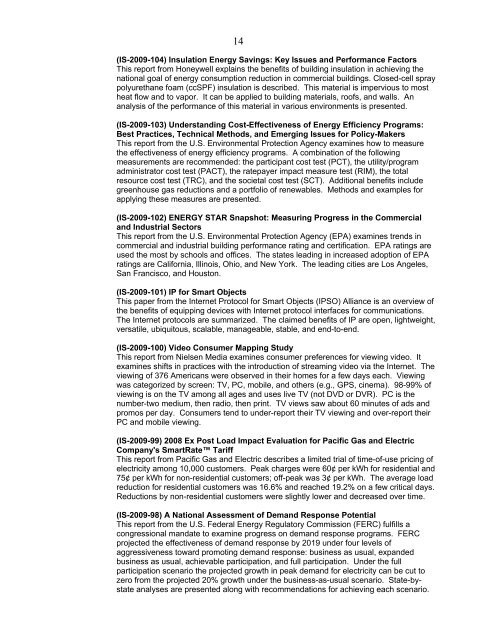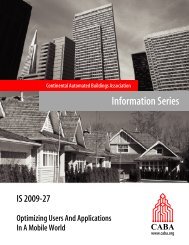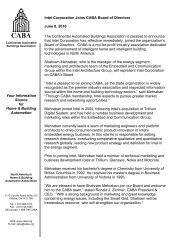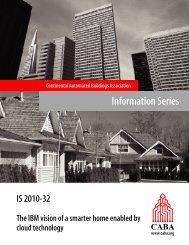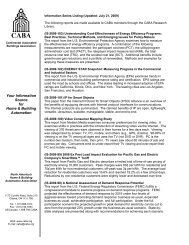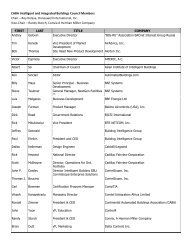Your Information Source for Home & Building Automation
Your Information Source for Home & Building Automation
Your Information Source for Home & Building Automation
You also want an ePaper? Increase the reach of your titles
YUMPU automatically turns print PDFs into web optimized ePapers that Google loves.
14<br />
(IS-2009-104) Insulation Energy Savings: Key Issues and Per<strong>for</strong>mance Factors<br />
This report from Honeywell explains the benefits of building insulation in achieving the<br />
national goal of energy consumption reduction in commercial buildings. Closed-cell spray<br />
polyurethane foam (ccSPF) insulation is described. This material is impervious to most<br />
heat flow and to vapor. It can be applied to building materials, roofs, and walls. An<br />
analysis of the per<strong>for</strong>mance of this material in various environments is presented.<br />
(IS-2009-103) Understanding Cost-Effectiveness of Energy Efficiency Programs:<br />
Best Practices, Technical Methods, and Emerging Issues <strong>for</strong> Policy-Makers<br />
This report from the U.S. Environmental Protection Agency examines how to measure<br />
the effectiveness of energy efficiency programs. A combination of the following<br />
measurements are recommended: the participant cost test (PCT), the utility/program<br />
administrator cost test (PACT), the ratepayer impact measure test (RIM), the total<br />
resource cost test (TRC), and the societal cost test (SCT). Additional benefits include<br />
greenhouse gas reductions and a portfolio of renewables. Methods and examples <strong>for</strong><br />
applying these measures are presented.<br />
(IS-2009-102) ENERGY STAR Snapshot: Measuring Progress in the Commercial<br />
and Industrial Sectors<br />
This report from the U.S. Environmental Protection Agency (EPA) examines trends in<br />
commercial and industrial building per<strong>for</strong>mance rating and certification. EPA ratings are<br />
used the most by schools and offices. The states leading in increased adoption of EPA<br />
ratings are Cali<strong>for</strong>nia, Illinois, Ohio, and New York. The leading cities are Los Angeles,<br />
San Francisco, and Houston.<br />
(IS-2009-101) IP <strong>for</strong> Smart Objects<br />
This paper from the Internet Protocol <strong>for</strong> Smart Objects (IPSO) Alliance is an overview of<br />
the benefits of equipping devices with Internet protocol interfaces <strong>for</strong> communications.<br />
The Internet protocols are summarized. The claimed benefits of IP are open, lightweight,<br />
versatile, ubiquitous, scalable, manageable, stable, and end-to-end.<br />
(IS-2009-100) Video Consumer Mapping Study<br />
This report from Nielsen Media examines consumer preferences <strong>for</strong> viewing video. It<br />
examines shifts in practices with the introduction of streaming video via the Internet. The<br />
viewing of 376 Americans were observed in their homes <strong>for</strong> a few days each. Viewing<br />
was categorized by screen: TV, PC, mobile, and others (e.g., GPS, cinema). 98-99% of<br />
viewing is on the TV among all ages and uses live TV (not DVD or DVR). PC is the<br />
number-two medium, then radio, then print. TV views saw about 60 minutes of ads and<br />
promos per day. Consumers tend to under-report their TV viewing and over-report their<br />
PC and mobile viewing.<br />
(IS-2009-99) 2008 Ex Post Load Impact Evaluation <strong>for</strong> Pacific Gas and Electric<br />
Company's SmartRate Tariff<br />
This report from Pacific Gas and Electric describes a limited trial of time-of-use pricing of<br />
electricity among 10,000 customers. Peak charges were 60¢ per kWh <strong>for</strong> residential and<br />
75¢ per kWh <strong>for</strong> non-residential customers; off-peak was 3¢ per kWh. The average load<br />
reduction <strong>for</strong> residential customers was 16.6% and reached 19.2% on a few critical days.<br />
Reductions by non-residential customers were slightly lower and decreased over time.<br />
(IS-2009-98) A National Assessment of Demand Response Potential<br />
This report from the U.S. Federal Energy Regulatory Commission (FERC) fulfills a<br />
congressional mandate to examine progress on demand response programs. FERC<br />
projected the effectiveness of demand response by 2019 under four levels of<br />
aggressiveness toward promoting demand response: business as usual, expanded<br />
business as usual, achievable participation, and full participation. Under the full<br />
participation scenario the projected growth in peak demand <strong>for</strong> electricity can be cut to<br />
zero from the projected 20% growth under the business-as-usual scenario. State-bystate<br />
analyses are presented along with recommendations <strong>for</strong> achieving each scenario.


